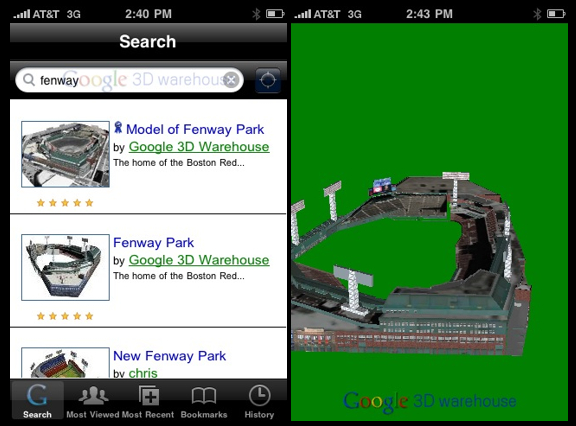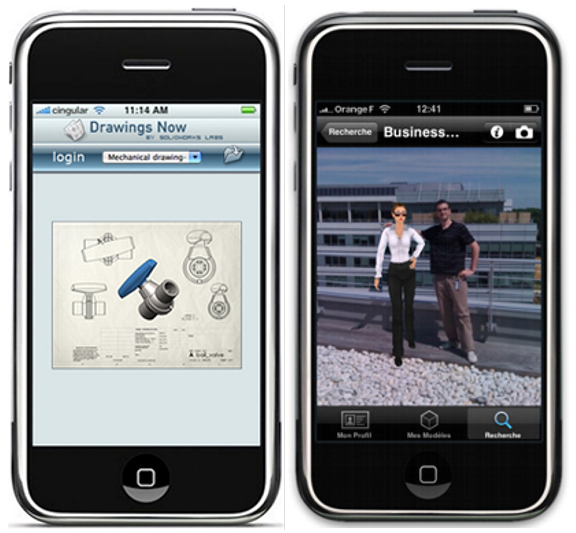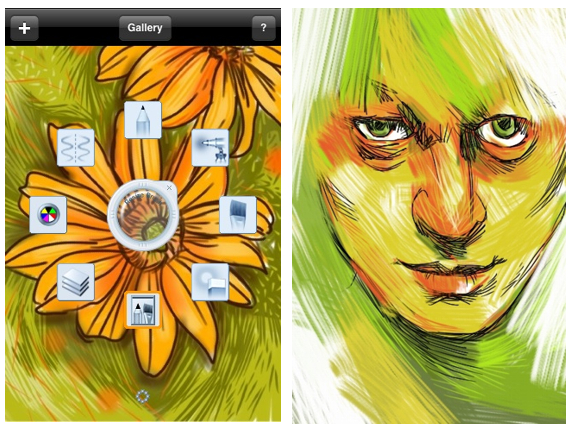Latest News
September 17, 2009

If you were interacting with CAD files on your iPhone, what would you like to be able to do?
The answer to that might unlock the gates to the mythical realm of hand-held CAD or CAD on the go.
Emerging Apps: One of the development teams exploring this territory is Dan Halabe and Chuck Han. Their brainchild, now available for purchase on iTunes App Store for a modest sum of $0.99, is called NaviCAD. Using the open-source COLLADA schema, Halabe and Han’s lightweight application lets iPhone users search, browse, download, and inspect the 3D content available in Google 3D Warehouse.
Taking advantage of the device’s touch sensitivity, Halabe and Han incorporated fingertip navigation methods: For instance, you can swipe on the screen with a single finger to rotate or spin a model, swipe it with double fingers to pand it, pinch it to zoom in, or double-tap on an area to focus on it. Just like 2D photos, models in NaviCAD reorient themselves when the device is repositioned.
Since iPhone and most hand-held computing devices now contain location awareness (via embedded GPS), Han and his colleagues added in NaviCAD the ability to automatically download and display 3D models of nearby surroundings. At the moment NaviCAD remains primarily a viewing platform, but its creators are open to the idea of adding new functions. They would welcome feedback on what functions they should add to the next release. (Send them to [email protected].)
On iTunes App Store, NaviCAD competes with cadTouch, a floor-plan sketching program for iPhone, now in its second release. Selling for $9.99, cadTouch R2 is designed for on-site area calculation, for those who need to take measurements, record points, sketch, and store diagrams and floor plans while working in the field.
Reviews of the app by users on iTunes App Store suggest the program needs more refinement. “Needs the ability [to] draw a line using the Snap function instead of typing [in] the [line’s] distance,” one pointed out. “Would love a finger-grid for angles,” another wrote. “It’s a good start but please [move] forward with updates,” another urged.
Old Names in the New Game: Big name CAD vendors are also eying the new frontier. Dassault Systemes tested the water by releasing an iPhone-friendly version of Drawings Now, its free online drawing viewer. The company envisions CAD users uploading design files to the Drawings Now portal, then allowing their partners and collaborators to view them remotely via a browser. In October 2007, the company updated the code so that the software could distinguish service calls made from an iPhone, thus allowing it to deliver the content in an interface customized for iPhone.
More recently, in June of this year, Dassault unveiled a new program in development: 3DVIA Mobile, an iPhone-compatible version of its 3D sketching application 3DVIA. One of the fun features included in 3DVIA Mobile is the option to insert a 3D model into a 2D backdrop (a photograph, for instance), then produce a composite image. (See “iPhone + Photos + 3D Objects = Yum!” at Dassault’s 3D Perspectives blog.)

In addition to developing 3D modeling and product lifecycle management (PLM) software, Dassault also operates two 3D content upload/download portals: 3DVIA.com and 3D ContentCentral. Both house user-created models and standard mechanical parts. Making objects on these sites accessible from iPhones would undoubtedly increase their appeal.
This week, another big name joined the race. Now available from iTunes App Store are Autodesk‘s SketchBook Mobile ($2.99) and SketchBook Mobile Express (free). These hand-held versions are developed specifically for iPhone and iPod Touch’s fingertip computing. The paid version SketchBook Mobile offers, among others, a bigger canvass area than the one in the free version and a series of preset brushes not included in the free version.

Play Now or Play Later: Not everyone believes in the rewards and riches that await in CAD on iPhone. Running a full-blown CAD program on the device is impractical because of the device’s small screen size and memory. Some consider the Apple Tablet, scheduled to debut in early 2010, as a better alternative.
The iPhone offers several advantages over traditional computers: ubiquity, portability, and touch computing. Since its debut, the device has become almost an indispensable item among road warriors, those who must do some or most of their work on the go. Its touch sensitivity allows developers to bypass the mouse and keyboard, a computing method that has always struck me as a serious handicap in 3D navigation.
I can hardly imagine someone creating a detailed CAD model from scratch using an iPhone. On the other hand, using the device to sketch out some rough ideas or access a low polygonmodel for approval and feedback seems a perfectly logical approach.
To see how SketchBook Mobile works, watch the video clip below, provided by Autodesk:
Subscribe to our FREE magazine, FREE email newsletters or both!
Latest News
About the Author
Kenneth Wong is Digital Engineering’s resident blogger and senior editor. Email him at [email protected] or share your thoughts on this article at digitaleng.news/facebook.
Follow DE





